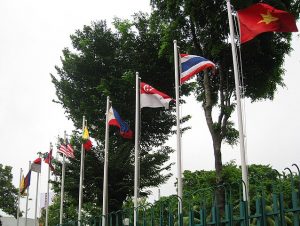December 12 marks the third anniversary of the Paris Agreement, a compact intended to catalyze a global reduction in carbon emissions. Yet all the statistics suggest the problem is getting worse: the latest report from the International Energy Agency (IEA) suggests 2018 is likely to set a new record for carbon emissions. This stat is all the more surprising, and alarming, since 2017 saw record levels of renewable energy installation.
How to explain this contradiction? Well, for one thing, with global populations rising by some 83 million a year, the vast fleet of new renewable facilities aren’t sufficient to meet our planet’s energy demands. Although wind and solar power are making huge gains in the electricity sector, fossil fuels account for exactly the same share of overall energy consumption as they did 30 years ago. Despite the admirable ambitions outlined in Paris, we still can’t afford to ratchet back our energy use.
Nowhere is this truer than in Southeast Asia. Although all 10 members of ASEAN, the region’s intergovernmental association, have submitted national pledges on climate action and agreed on grandiose action plans, they currently lie at the bottom of the global league table for renewable energy deployment – and current trends suggest that it will take considerable efforts to reroute this course. For instance, Thailand’s new government has virtually brought renewables expansion to a standstill and Malaysia is the only country in the world to reduce its fleet of solar panels in recent years. It’s not surprising that the IEA expects coal will still be Southeast Asia’s primary fuel source by 2040.
Yet in many ways, this reluctance to abandon traditional fuel sources is easily explained. Southeast Asia’s population increased by 23 percent between 2000 and 2017, reaching around 700 million people, and it is expected to rise by a further 20 percent by 2050. This remarkable growth, which has been accompanied by rapid urbanization and economic development, has placed huge demands on the energy sector, and will continue doing so – the IEA expects Southeast Asia’s energy demand to grow by almost two-thirds by 2040. Although the costs of wind and solar technologies are falling dramatically, coal remains attractive due to the vast reserves found across the ASEAN region, notably in Indonesia. Neighboring countries such as China and India may be investing heavily in nuclear power as they attempt to wean themselves off fossil fuels, but this would be a risky bet in Southeast Asia, given the number of earthquakes and tsunamis that have struck in recent years.
Given all these factors, there’s little chance that Southeast Asia will halt its reliance on coal anytime soon. The potential consequences are clear: analysts expect that, under a “business as usual” scenario, the region’s carbon dioxide emissions will rise by 5.7 percent by 2030. But this scenario is certainly not inevitable. In fact, the IEA suggests that the ASEAN region can realize major emissions reductions simply by making its power sector more efficient, accompanying its renewables investment with a move towards low-carbon, ‘clean coal’ technologies.
The most promising of these technologies is carbon capture and storage (CCS), which siphons the carbon dioxide produced during the coal-burning process and sequesters it for subsequent re-use. Although CCS is still relatively untried in the ASEAN region, it is rapidly gaining ground elsewhere – notably in China, fast becoming a global leader. The IEA has predicted that, if properly harnessed, CCS can provide 20 percent of the total carbon cuts needed to keep emissions within reasonable boundaries over the next 30 years.
Encouragingly, ASEAN leaders have expressed willingness to explore such technologies. At the latest ASEAN Forum on Coal, officials pledged to share technical capacity for the deployment of low-emission coal innovations and explore the potential of CCS. Countries like Thailand are also pushing individual strategies towards cleaner coal technologies, notably those used in “super-critical” power plants that achieve efficiency gains by burning coal at higher temperatures.
However, if Southeast Asia is to deliver on its grandiose promises regarding cleaner coal technologies, it needs to overcome a series of challenges. The vast development gap across the region, from the high-tech boom in Singapore to the travails of Indonesia and Thailand, makes it extremely difficult to deliver a unified policy. Furthermore, much of the power systems architecture in countries like Vietnam is based on cheap, outdated technology that may not be receptive to modernization.
Most significantly, cleaner power technologies remain expensive. Analysts suggest the installation of CCS can increase the cost of electricity from new power plants by up to 90 percent, a prohibitive figure for developing ASEAN countries with soaring populations. Industrialized states have talked about helping their less developed counterparts, but so far many have been unable to back up these promises. For instance, the UN’s Green Climate Fund, launched in 2010, has thus far delivered less than half the $10.3 billion originally promised. Far from understanding the challenges facing the ASEAN region, the World Bank has turned its back by pulling out of all coal projects. Little wonder aid workers talk of a “lack of trust” in the developing world, which will only make its leaders more reluctant to embrace the global climate change agenda.
To be fair, there are some signs of momentum to help the developing world increase baseload capacity without causing climate catastrophe. At the annual UN climate talks in Katowice, Poland next month, the US administration plans to hold an event on ways that developing countries in particularly can use technologies to burn fossil fuels more cleanly.
Indeed, for Southeast Asia – whose emissions problem is a microcosm of the global challenge – these technologies will be a game changer. After all, despite the dire threat it faces from climate change, the region’s demographic and economic challenges mean it simply can’t afford to stop burning coal. High-efficiency, low-emissions technologies will thus be a critical means to bridge the gap.
Grace Guo is a Vienna-based researcher and a program associate for an NGO focused on Asian politics.

































